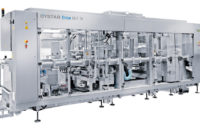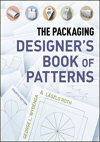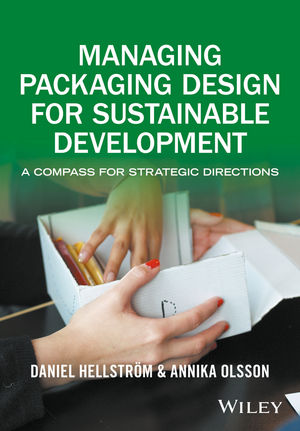Sharp’s Hawk Evolution VFFS machine design innovations improve uptime.
New vertical form fill seal machine introduced

 Sharp Packaging Systems (www.sharppackaging.com) has introduced its first vertical form fill and seal (VFFS) machine, called the Hawk EvolutionTM. The company’s engineers analyzed all the problems that are typically encountered with VFFS machines and solved them so handily that typical uptime is expected to improve dramatically. The new machine is produced in Wisconsin and has the smallest footprint in the industry for the bag size it will manufacture. It can make a bag up to 12” wide and 18” long. Its motor is a Kollmorgen stepper motor, which is maintenance free, and designed to run for hundreds of millions of cycles with little to no maintenance.
Sharp Packaging Systems (www.sharppackaging.com) has introduced its first vertical form fill and seal (VFFS) machine, called the Hawk EvolutionTM. The company’s engineers analyzed all the problems that are typically encountered with VFFS machines and solved them so handily that typical uptime is expected to improve dramatically. The new machine is produced in Wisconsin and has the smallest footprint in the industry for the bag size it will manufacture. It can make a bag up to 12” wide and 18” long. Its motor is a Kollmorgen stepper motor, which is maintenance free, and designed to run for hundreds of millions of cycles with little to no maintenance.
“When our engineers looked at the VFFS machines that were available, they identified many areas with opportunities for improvements,” says Micah McDowell, vice president of sales and marketing at Sharp. “We decided to spend time engineering ways to operate and maintain the machine more efficiently, so that we could jump into this market with the best machine available.”
The Hawk Evolutionaccommodates three bag styles: pillow bag, typically used in the potato chip industry; a gusseted bag; and a flat bottom bag, commonly used for coffee in one pound packages. It will run and seal just about any structure of polyethylene, laminated or metalized film, or foil. Businesses that use the Hawk Evolution for packaging include companies that manufacture or process candy, nuts, salted snacks, IQF (individually quick frozen) foods, pet food, fresh produce, hot foods like soup and gravy, and coffee. There are also applications for the medical industry.
Reduced Maintenance
A double stack Kollmorgen stepper motor operates the jaw drive mechanism. This motor is known for its long life expectancy and dependability, and is used in a wide variety of industries. There are very few moving parts in the drive mechanism for the jaws, so there are very few parts that could wear out. The only wear parts that would be slotted for routine replacement are the high speed bearings, which are very easy to change. All of the parts for the Hawk Evolutionare off the shelf, available through a wide variety of distributors.
Also included is a motorized unwind; the spindle on which the roll sits is turned by a DC motor. This motor aids in feeding the film off the roll, helps to maintain a constant tension on the film, and reduces stress on the pull belts, allowing for a smooth movement of the film through the system.
Quick Changeovers
When a bag width change is needed, the Hawk is equipped from the film spindle through the pull belt mechanism with no tool change features. The forming tubes have quick release locks for fast, easy changeovers. The pull belt assembly is self-centering, so after the forming tube change, the pull belts return to the proper position automatically. As a result, there is less time and material wasted.
Printer Options
The number of printers required is optional, dictated by the particular application. The Hawk Evolution can accommodate up to 2 printers. The most prevalent printers used are the 53 mil and the 107 mil Videojet printers which have a thermal transfer printing technology to imprint bar codes, graphics and alphanumerics directly on the package.
Edge Guide
The Hawk Evolution is equipped with an edge guide system, a pair of “eyes” that watches the edge of the film. If the film wanders one way or the other, the eyes communicate with an air cylinder that will move the whole back stand, so that the film will be centered on the forming tube. This feature is important to keep the vertical seal in its proper position.
Easy Troubleshooting
The Hawk Evolution can be customized with a powerful PC based system, which stores the manuals for the HMI which include troubleshooting video clips to view right on the computer screen. The operator can pull up a video on how to fix any problem. Videojet or print label programs can also be stored in the system.
There is an Allen-Bradley PLC (programmable logic controller) in the machine, the MicroLogix 1400. All of the prime movers have sensors on their openings and closings.
Sensor driven step logic program is used to animate the machine. There are no delays between steps. As soon as it completes a job, it immediately moves to the next step. This approach should optimize the machine cycle speed. If a step isn’t completed, a sensor sends a fault notice to the screen, and the operator knows exactly what happened and where to look for the problem. It is especially helpful in troubleshooting for wear parts.
Parts and Service
The company offers a maintenance package called Total Systems Care for all of its machines. This program includes: installation and training; free replacement parts for one year; two preventive maintenance visits; free telephone technical support; discounted labor rates; preferred service scheduling; and trade-in incentives for machinery. Parts and service are available through a network of distributors across the U.S.
Looking for a reprint of this article?
From high-res PDFs to custom plaques, order your copy today!







